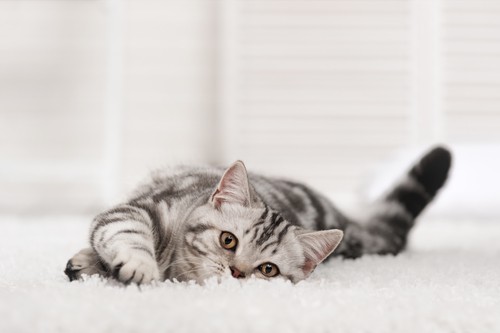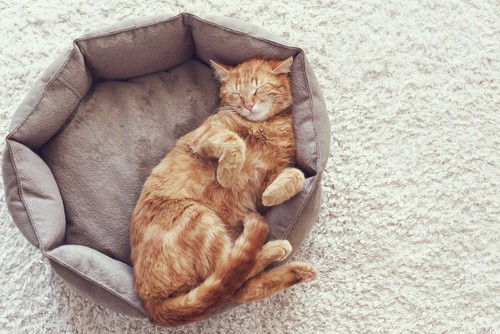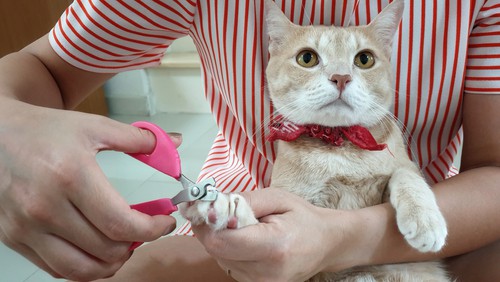
How To Remove Mold Smell from Carpet?
August 11, 2020
The Unspoken Health Benefits of Carpet
October 5, 2020How To Keep Your Cat From Scratching The Carpet?

Your feline friend is a creature of instinct. Sometimes these instincts can be quite destructive on your living environment. If you’ve ever had a cat, you’ve surely come home to find scratch marks and damage to your carpeting. How to keep your cat from scratching the carpet?
On the one hand, you can’t really blame a cat for doing what they do. Scratching is a part of their health and grooming routine. They scratch to sharpen their claws and as a way to reduce stress levels.
Let’s take a look at ways to reduce the destructive effect of your cat’s claws on your carpeting while taking into consideration your cat’s needs.
How To Keep Your Cat From Scratching The Carpet? –
Horizontal Scratching Pads

Let’s face it, your cat needs to scratch. It’s part of their identity. Instead of trying to thoroughly (and likely unsuccessfully) training the urge to scratch out of your feline, establish an appropriate non-destructive spot they can scratch other than your carpet.
There are hoards of horizontal scratching pads on the market that your cat will love. Some are made of fibrous fabrics or plastics and others are made from corrugated cardboard.
Identify the appropriate product in your price range and put several around your home to give your frisky friend a place to let loose.
If you catch your cat scratching somewhere inappropriate, direct them to the pad. Be persistent and consistent to ensure the results you seek. Make sure to reward your kitty when they scratch where they are allowed. Positive reinforcement goes a long way.
How To Keep Your Cat From Scratching The Carpet? –
Spray carpet with a pheromonal scent or essential oils

There are quite a few products on the market that help prevent cats from reeking their damage to your belongings. Pheromonal scent sprays are rather effective. If your cat thinks that another cat has already sprayed the carpet they will be less likely to claw it up.
Feliway makes direct sprays or creates plug-in diffusers that will elevate your cat’s food while preventing their more destructive tendencies.
Essential oils deter some cats as well. Dilute lavender, lemongrass, citronella, or tea tree oil in a spray bottle and give your carpet a spray. Most of the scent will quickly dissipate but your cat’s sensitive nose will notice for quite some time.
Train with a spray bottle

This method is pretty self-explanatory. When you see your four-legged friend tearing up the carpet, spray them with water. Cat’s notoriously hate to be sprayed with anything. If you are consistent in dishing out the discipline, you will surely alter the behavior.
This approach is more hands-on than some of the other options. You likely have a busy life and can’t just sit around all day waiting for your time to shine. Keep a spray bottle handy just in case you see anything but you’ll likely need to try a combination of other approaches as well.
Cover up the spot

If possible, cover the spot where your cat likes to scratch. Move a rug or a piece of furniture over the spot your cat goes to town. This might not be possible depending on the location or extent of your problem.
Some cats isolate all their destructive scratching behavior to one locale. Observe your cat and see if they stick to one area or scratch around a bit.
Cut or cap your cat’s claws

Cutting your cat’s claws won’t necessarily stop them from scratching but it will minimalize the damage that they are able to inflict. You can cut your cat’s claws with the appropriate nail cutting tool about once a month.
Make sure you don’t cut their claws too short though as they may bleed and experience a fair amount of pain.
Several companies sell caps for your cat’s claws. Any major pet store sells these helpful accessories. They take a little bit of time and know-how to install so you may need to do a bit of research or get a little training.
Alternatively, some people have their cats permanently declawed. There is debate surrounding the ethics of this practice, so it’s crucial to be fully informed before making such a decision.
Most people only declaw their cat’s front paws, leaving them with their back claws intact for gripping and defensive purposes. Cats typically only engage in destructive scratching behaviors with their front paws.



